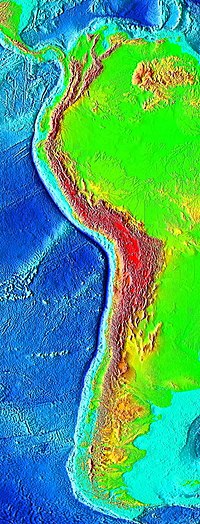Peru–Chile Trench

The Peru–Chile Trench, also known as the Atacama Trench, is an oceanic trench in the eastern Pacific Ocean, about 160 kilometres (100 mi) off the coast of Peru and Chile. It reaches a maximum depth of 8,065 metres (26,460 ft) below sea level in Richards Deep and is approximately 5,900 kilometres (3,666 mi) long; its mean width is 64 kilometres (40 mi) and it covers an expanse of some 590,000 square kilometres (228,000 mi²).
The trench is a result of the eastern edge of the Nazca Plate being subducted under the South American Plate. The trench subducts two seamount ridges; the Nazca Ridge and the Juan Fernández Ridge.
The Peru-Chile Trench, the forearc and the western edge of the central Andean plateau (Altiplano), delineate the dramatic "Bolivian Orocline" that defines the Andean slope of southern Peru, northern Chile, and Bolivia.
From the Chile Triple Junction to Juan Fernández Ridge the trench is filled with 2.0–2.5 km of mainly turbidite sediments, creating a flat bottom topography.
See also
- Earthquakes
